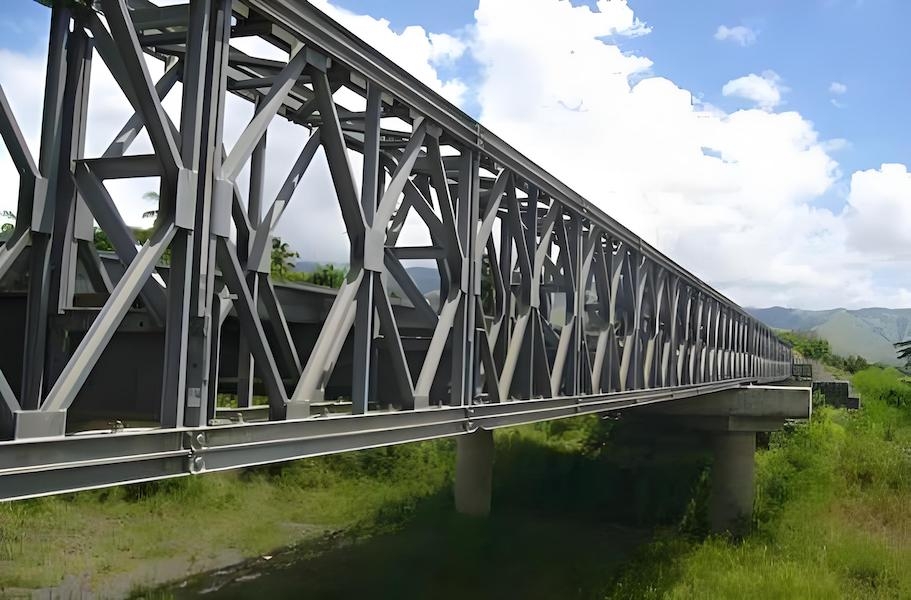Prefabricated steel bridges have gained significant attention in modern engineering due to their efficiency, cost-effectiveness, and adaptability. These structures are designed to meet various international standards, including those set by Europe, America, and Australia. This article explores how prefabricated steel bridges can comply with these standards, focusing on design, materials, construction methods, and safety regulations.
Understanding Prefabricated Steel Bridges
Definition and Overview
Prefabricated steel bridges are structures made from steel components that are manufactured off-site and assembled on-site. This method allows for quicker construction times and reduced labor costs. The components are designed to fit together seamlessly, ensuring structural integrity and durability. The prefabrication process not only streamlines construction but also minimizes the impact of weather delays, which can significantly extend project timelines. By utilizing advanced manufacturing techniques, engineers can create complex designs that would be challenging to achieve with traditional construction methods.
Advantages of Prefabricated Steel Bridges
The use of prefabricated steel bridges offers several advantages:
Speed of Construction: Components can be manufactured simultaneously while site preparation occurs, significantly reducing overall project timelines. This rapid construction process is particularly beneficial in urban areas where minimizing disruption is crucial.
Quality Control: Off-site manufacturing allows for better quality control, as components are produced in a controlled environment. This leads to fewer defects and a higher overall quality of the finished product, which is essential for ensuring long-term performance.
Reduced Environmental Impact: Shorter construction times lead to less disruption to the surrounding environment and reduced waste. Additionally, the use of steel, which is highly recyclable, contributes to a more sustainable construction practice.

Compliance with International Standards
European Standards
In Europe, prefabricated steel bridges must comply with the Eurocodes, a set of harmonized technical rules for the design of structures. Key aspects include:
Structural Integrity: Eurocode 3 outlines the design of steel structures, ensuring that bridges can withstand various loads and environmental conditions. This includes considerations for dynamic loads such as wind and seismic activity, which are critical for ensuring safety and longevity.
Durability: Materials used must be resistant to corrosion, particularly in harsh climates. This is addressed in Eurocode 3, which specifies protective measures such as galvanization or painting. The emphasis on durability ensures that bridges can maintain their structural integrity over time, reducing the need for frequent repairs.
Safety Regulations: Compliance with EN 1991 (Actions on Structures) ensures that bridges can handle dynamic loads, including traffic and environmental factors. This comprehensive approach to safety helps to mitigate risks associated with bridge failure, protecting both users and the surrounding community.
American Standards
In the United States, the American Association of State Highway and Transportation Officials (AASHTO) sets the standards for bridge design. Key considerations include:
Load Ratings: AASHTO LRFD Bridge Design Specifications provide guidelines for determining the load-carrying capacity of bridges, ensuring they can support expected traffic loads. This includes considerations for both static and dynamic loads, which are essential for maintaining safety under various conditions.
Material Specifications: The use of high-strength steel is encouraged, with specific grades and properties outlined in AASHTO standards. This focus on material quality ensures that bridges can withstand the rigors of daily use and environmental challenges.
Construction Practices: AASHTO emphasizes the importance of following best practices during construction to ensure safety and longevity. This includes guidelines for quality assurance and control, which are critical for maintaining high standards throughout the construction process.
Australian Standards
Australia has its own set of standards, primarily governed by AS 5100, which covers the design and construction of bridges. Important elements include:
Design Requirements: AS 5100 specifies the design criteria for various types of bridges, including load factors and material properties. This comprehensive framework ensures that all aspects of bridge design are considered, from initial concept to final construction.
Environmental Considerations: Australian standards require that bridges be designed to withstand local environmental conditions, including wind, seismic activity, and flooding. This focus on environmental resilience is crucial for ensuring the long-term viability of infrastructure in diverse climates.
Maintenance and Inspection: Regular maintenance protocols are mandated to ensure the ongoing safety and functionality of the bridge. This proactive approach to maintenance helps to identify potential issues before they become critical, extending the lifespan of the structure.

Design Considerations for Prefabricated Steel Bridges
Structural Design
The structural design of prefabricated steel bridges must consider various factors, including:
Span Length: The design must accommodate the required span while ensuring stability and strength. Engineers often use advanced modeling techniques to optimize the design for both performance and cost-effectiveness.
Load Distribution: Proper load distribution is crucial to prevent structural failure. Engineers must calculate the expected loads and design the bridge accordingly, taking into account factors such as traffic patterns and environmental conditions.
Connection Details: The connections between prefabricated components must be designed to handle stresses and strains effectively. This includes considering the types of joints used and ensuring that they can accommodate any movement or deformation that may occur over time.
Aesthetic and Functional Design
Beyond structural integrity, the aesthetic and functional aspects of bridge design are essential. This includes:
Integration with Surroundings: Bridges should complement the local environment and architecture. Thoughtful design can enhance the visual appeal of a bridge, making it a landmark rather than just a functional structure.
User Experience: Consideration for pedestrians and cyclists is vital, ensuring safe and accessible pathways. This focus on user experience can encourage more sustainable transportation options and improve community connectivity.
Construction Methods
Off-Site Manufacturing
The prefabrication process typically involves:
Component Fabrication: Steel components are cut, shaped, and assembled in a factory setting, allowing for precise manufacturing. This controlled environment minimizes the risk of errors and ensures that components meet strict quality standards.
Quality Assurance: Each component undergoes rigorous testing to ensure it meets the required standards before being transported to the construction site. This includes structural testing and inspections to verify that all specifications are met.
On-Site Assembly
Once the components arrive at the site, the assembly process includes:
Foundation Preparation: Proper foundation work is essential to support the bridge's weight and ensure stability. Engineers must assess soil conditions and design foundations that can accommodate the specific loads imposed by the bridge.
Erection of Components: Using cranes and other machinery, the prefabricated components are assembled according to the design specifications. This process requires careful coordination to ensure that all components fit together correctly and that safety protocols are followed.
Safety and Maintenance
Safety Protocols
Safety is paramount in the construction and operation of prefabricated steel bridges. Key safety protocols include:
Worker Safety: Ensuring that all workers are trained in safety practices and that protective equipment is used. This includes regular safety meetings and training sessions to keep safety at the forefront of construction activities.
Site Safety: Implementing measures to protect the public and the environment during construction. This may involve traffic management plans, noise control measures, and environmental protection strategies to minimize the impact of construction activities.
Maintenance Practices
Regular maintenance is crucial for the longevity of prefabricated steel bridges. This includes:
Inspections: Routine inspections to identify any signs of wear or damage. These inspections should be conducted by qualified personnel who can assess the structural integrity of the bridge and recommend necessary repairs.
Repairs: Prompt repairs to address any issues that arise, ensuring the bridge remains safe for use. A well-defined maintenance plan can help prioritize repairs and allocate resources effectively.
Conclusion
Prefabricated steel bridges represent a modern solution to infrastructure needs, offering numerous benefits while adhering to stringent international standards. By understanding the requirements set forth by European, American, and Australian standards, engineers and builders can design and construct bridges that are not only efficient and cost-effective but also safe and durable. As technology advances, the potential for prefabricated steel bridges will continue to grow, paving the way for innovative solutions in the field of civil engineering. The ongoing evolution of materials, design techniques, and construction methods will further enhance the capabilities of prefabricated steel bridges, ensuring they remain a vital component of modern infrastructure development.
Frequently Asked Questions regarding Prefabricated Steel Bridges
1. What are the primary benefits of using prefabricated steel bridges over traditional construction methods?
Answer: The primary benefits include faster construction times, improved quality control due to factory manufacturing, reduced labor costs, and minimized environmental impact. Prefabricated components can be assembled quickly on-site, leading to less disruption and a more efficient construction process.
2. How do prefabricated steel bridges ensure compliance with safety standards?
Answer: Prefabricated steel bridges comply with safety standards by adhering to specific design codes, such as the Eurocodes in Europe, AASHTO standards in the U.S., and AS 5100 in Australia. These codes outline requirements for load capacity, material specifications, and construction practices, ensuring that bridges can withstand expected loads and environmental conditions.
3. What materials are commonly used in the construction of prefabricated steel bridges?
Answer: Common materials include high-strength steel, which is favored for its durability and load-bearing capacity. Additionally, protective coatings such as galvanization or paint are often applied to prevent corrosion, especially in harsh environmental conditions.
4. How does the design of prefabricated steel bridges accommodate environmental factors?
Answer: The design process incorporates considerations for local environmental conditions, such as wind loads, seismic activity, and potential flooding. Engineers use advanced modeling techniques to ensure that the bridge can withstand these factors, enhancing its resilience and longevity.
5. What maintenance practices are recommended for prefabricated steel bridges?
Answer: Recommended maintenance practices include regular inspections to identify wear or damage, prompt repairs to address any issues, and routine cleaning to prevent corrosion. A well-defined maintenance plan helps prioritize tasks and allocate resources effectively, ensuring the bridge remains safe and functional over time.





